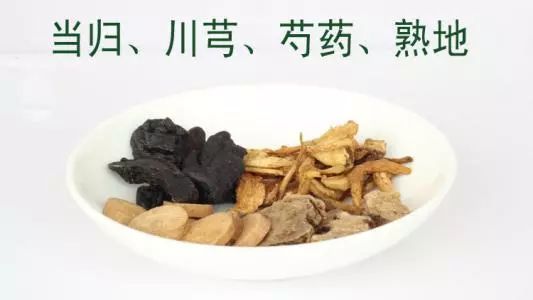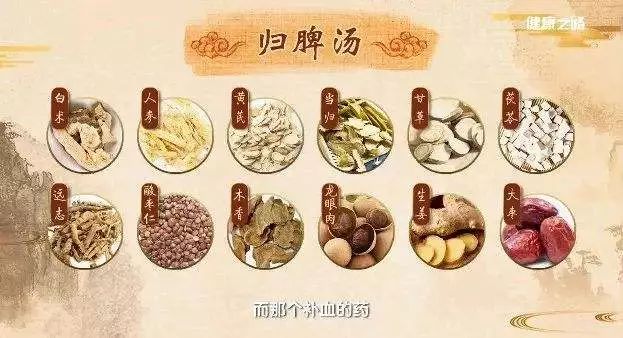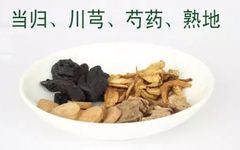Click on the above“CC Health V Path”, then click“Follow”
Traditional Chinese Medicine experts and masters discuss health and wellness
Free subscription, essential for health and wellness!
“Blood-Boosting Agents”
Indications:Blood deficiency syndrome.
Main Symptoms:Pale complexion, dizziness, pale lips and nails, palpitations, insomnia, pale tongue with thin pulse, or irregular menstruation in women, light flow with pale color, amenorrhea, etc.
Commonly Used Herbs:Shu Di Huang (Rehmannia), Dang Gui (Angelica), Bai Shao (White Peony), Ejiao (Donkey-hide Gelatin), Longan Meat (Longan).
Representative Formulas:Si Wu Tang (Four Substance Decoction), Dang Gui Bu Xue Tang (Dang Gui Blood-Boosting Decoction), Gui Pi Tang (Restore the Spleen Decoction), etc.

The following formulas should be taken under the guidance of a physician.
1. Si Wu Tang (Four Substance Decoction)
In Si Wu Tang, Dang Gui, Chuan Xiong, Bai Shao, and Shu Di Huang harmonize the blood and nourish the essence, addressing various blood-related ailments.
Formula Composition:Dang Gui (Angelica) 9g, Chuan Xiong (Szechuan Lovage) 6g, Bai Shao (White Peony) 9g, Shu Di Huang (Rehmannia) 15g.
Functions and Indications:Tonifies and invigorates the blood. Used for symptoms of blood deficiency such as dizziness, palpitations, insomnia, irregular menstruation, amenorrhea, abdominal pain, pale complexion, pale tongue, and thin pulse.
Simple Formula Verse:Blood-boosting Four Substance Decoction, Dang Gui, Chuan Xiong, Shu Di, Bai Shao.
Formula Explanation:This formula uses Shu Di Huang as the monarch herb, which is sweet and warm, nourishing the essence and tonifying the blood; Dang Gui serves as the minister herb, which is pungent and warm, invigorating blood and promoting qi; Bai Shao and Chuan Xiong are assistant herbs, nourishing blood, calming yin, and alleviating pain. The combination of these four herbs focuses on tonifying blood without stagnation, promoting blood flow without harming it, achieving the function of nourishing and regulating blood.
This formula is a foundational recipe for nourishing and regulating blood, originally designed for external injuries, later adapted for various women’s ailments, and has become a universal formula for treating related diseases across different specialties, demonstrating its influence and intricacies.
This formula is commonly used in modern treatments for blood-related diseases, coronary heart disease, women’s menstrual irregularities, and conditions related to pregnancy and postpartum.
Clinical Insights:The driving force of a person is qi and blood; diseases arise from qi and blood. In discussing blood-related diseases, there are few actual blood diseases, with most being deficiency syndromes. To treat diseases, one must treat the blood, which is the hallmark of skilled practitioners. Si Wu Tang is the fundamental formula for nourishing and regulating blood; no practitioner can do without it, as stated in the “Song of Decoction Head” that “this formula addresses all blood-related ailments.” Shu Di Huang has both raw and cooked forms; use the cooked form for its nourishing properties; if blood diseases are heat-related, one may switch to raw Shu Di Huang. Bai Shao has red and white varieties; use the white for its gentleness; if blood diseases are related to stasis, one may switch to red Bai Shao. The renowned physician Pu Fuzhou stated: “This formula is universally applicable for all blood diseases. For blood stasis, replace white Bai Shao with red Bai Shao; for blood heat, replace cooked Shu Di Huang with raw Shu Di Huang. The dosage of Chuan Xiong should be small, about half that of Dang Gui, while Shu Di Huang should be double that of Dang Gui.” (From Pu Fuzhou’s Medical Experience) This encapsulates Pu’s clinical experience.
2. Dang Gui Bu Xue Tang (Dang Gui Blood-Boosting Decoction)
Dang Gui Bu Xue Tang combines Dang Gui and Huang Qi, effectively addressing blood deficiency, generating blood, and alleviating heat, particularly for women with blood deficiency.
Formula Composition:Huang Qi (Astragalus) 30g, Dang Gui (Angelica) 6g.
Functions and Indications:Tonifies qi and generates blood. Used for symptoms of blood deficiency with fever, such as red face, thirst, large and weak pulse, and lack of strength upon pressure; also treats women with blood deficiency and fever during menstruation or postpartum, headaches, or non-healing sores.
Formula Explanation:This formula heavily utilizes Huang Qi as the monarch herb, tonifying lung and spleen qi, securing the exterior, and providing the source for qi and blood generation; Dang Gui serves as the minister herb, nourishing blood and harmonizing the essence, promoting blood circulation. The combination of these two herbs, one as monarch and the other as minister, balances yin and yang, qi and blood, allowing for mutual generation, ultimately achieving the goal of securing the exterior and eliminating heat.
This formula is a representative recipe for treating blood deficiency with fever, based on the principle that “tangible blood cannot be quickly generated, while intangible qi must be urgently secured,” emphasizing the use of Huang Qi to tonify the righteous qi and stabilize the floating yang; supplemented with blood tonification to secure the foundation and nourish the yin blood.
This formula is commonly used in modern treatments for allergic purpura, autoimmune pancytopenia, diabetes with ulcers, and functional uterine bleeding.
Clinical Insights:This formula is named “Dang Gui Bu Xue Tang,” yet it uses the qi-tonifying Huang Qi as the monarch herb, which may seem strange! However, it is not; blood relies on qi, and qi supports blood. The treatment of this formula addresses blood deficiency as the root of the disease; while the floating yang is an urgent symptom. “At this time, the yang qi has left the interior and ascended to the exterior, fearing that immediate stabilization of the interior may not be sufficient, thus it is necessary to secure the exterior to retain it.” (From Zhang Bingcheng’s “Convenient Reading”) The physician emphasizes the use of Huang Qi, achieving a dual approach of treating both the symptoms and the root: addressing the symptoms by immediately stabilizing the floating yang to reduce fever, while also treating the root to ensure blood has a foundation, restoring the deficiency. Qi generates blood, and with the effective function of Dang Gui in nourishing blood and harmonizing the essence, both functions work together to achieve blood tonification. Tonifying qi and generating blood is a major principle in TCM treatment, and Li Gao’s use of these two herbs exemplifies this perfectly, demonstrating profound understanding of their application.

3. Gui Pi Tang (Restore the Spleen Decoction)
Gui Pi Tang includes four monarch herbs: Huang Qi, Dang Gui, Longan Meat, and Suan Zao Ren, which tonify qi, strengthen the spleen, and nourish the heart.
Formula Composition:Bai Zhu (Atractylodes) 18g, Fu Shen (Poria) 18g, Huang Qi (Astragalus) 18g, Longan Meat (Longan) 18g, Suan Zao Ren (Sour Jujube Seed) 18g, Ren Shen (Ginseng) 9g, Mu Xiang (Aucklandia) 9g, Zhi Gan Cao (Honey-fried Licorice) 6g, Dang Gui (Angelica) 3g, Yuan Zhi (Polygala) 3g, Sheng Jiang (Fresh Ginger) 5 slices, Da Zao (Jujube) 1 piece.
Functions and Indications:Tonifies qi and nourishes blood, strengthens the spleen, and nourishes the heart. Used for symptoms of both heart and spleen qi and blood deficiency, such as palpitations, forgetfulness, insomnia, shortness of breath, fatigue, poor appetite, pale yellow complexion, pale tongue with thin white coating, and weak pulse; also for women with uterine bleeding, excessive menstruation, or blood in stool, and purpura.
Formula Explanation:This formula uses Huang Qi and Longan Meat as the monarch herbs, tonifying spleen qi and nourishing heart blood; Ren Shen, Bai Zhu, Dang Gui, and Suan Zao Ren serve as minister herbs, enhancing spleen and stomach function, calming the mind, and stabilizing the spirit; Fu Shen, Yuan Zhi, Mu Xiang, and Zhi Gan Cao act as assistant herbs, nourishing the heart, calming the mind, and harmonizing the formula; Sheng Jiang and Da Zao serve as guides, regulating the spleen and stomach, and promoting digestion. The combination of these herbs focuses on treating both the heart and spleen, primarily tonifying the spleen, with a dual focus on qi and blood, ensuring that qi promotes blood generation and both are abundant.
This formula is a commonly used recipe for tonifying the heart and spleen, having been relied upon by many physicians since its inception in the Song Dynasty, with its functions continuously supplemented, improved, and innovated, yielding many modern research results.
This formula is commonly used in modern treatments for neurasthenia, heart disease, gastrointestinal bleeding, gum bleeding, uterine developmental disorders, functional uterine bleeding, uterine fibroids, thrombocytopenic purpura, leukopenia, aplastic anemia, menopausal syndrome, arthralgia, and elderly skin itching.
Clinical Insights:Gui Pi Tang focuses on nourishing the spleen, which is its primary function, reflecting the original intention of its creator, the Song Dynasty physician Yan Yonghe, who developed it based on the Si Jun Zi Tang (Four Gentlemen Decoction); the Yuan Dynasty physician Wei Yilin discovered its application in treating spleen qi deficiency leading to bleeding, thus enhancing its function related to blood disorders closely linked to the heart; the Ming Dynasty physician Xue Ji added Dang Gui and Yuan Zhi to the original formula, significantly increasing its heart-nourishing elements; the Qing Dynasty physician Wu Qian further summarized and improved upon the experiences of predecessors in the “Golden Mirror of Medicine,” making it a representative prescription for simultaneous treatment of the heart and spleen.
The essence of this formula lies in its focus on postnatal treatment, embodying the principle of nourishing the spleen to support the heart and tonifying qi to generate blood. The evolution of this formula’s composition and function illustrates that the success of a prescription or treatment method is the result of long-term experimentation and application by countless physicians. The continuous progress and development of TCM is achieved through practice and innovation.
This article is an excerpt from the internet.


